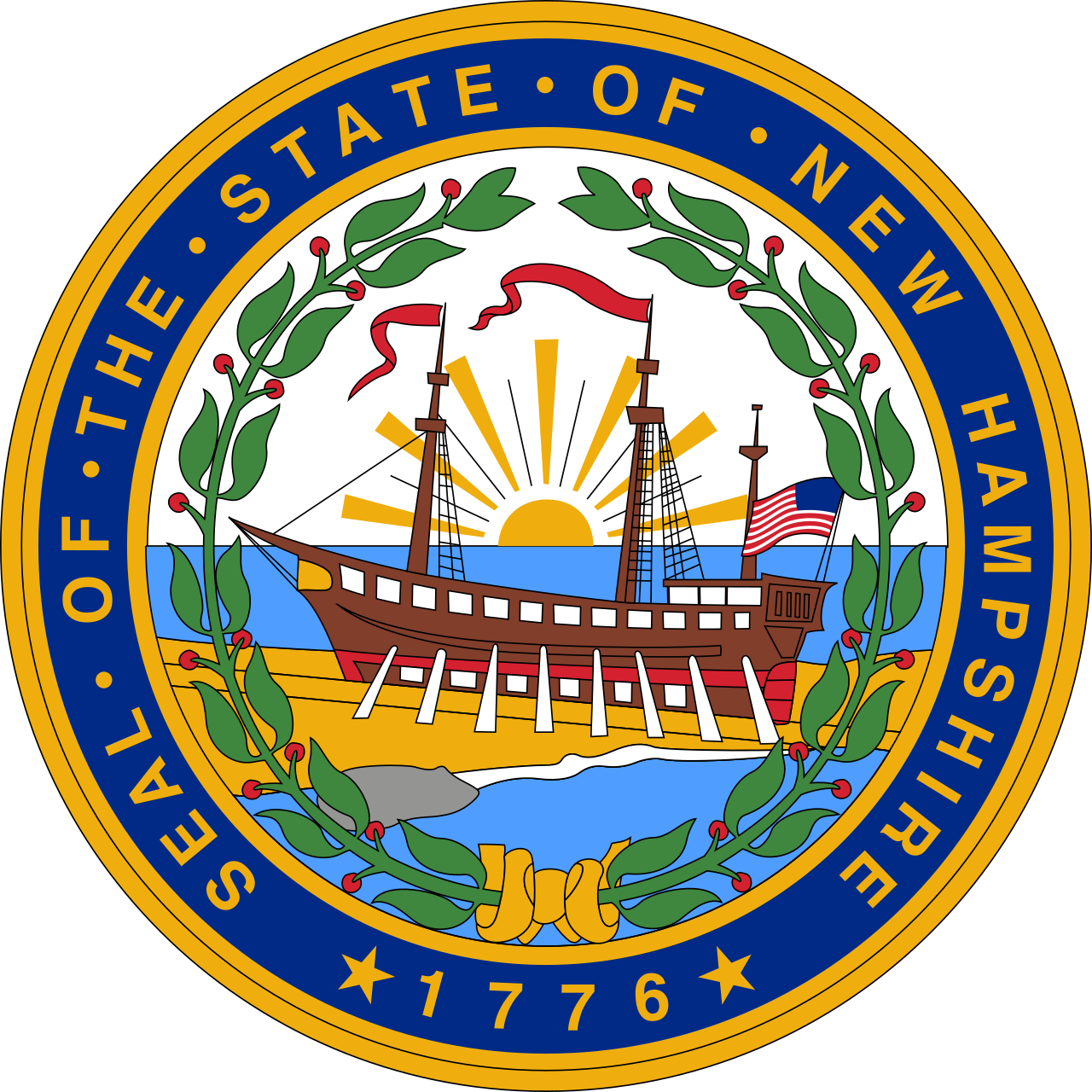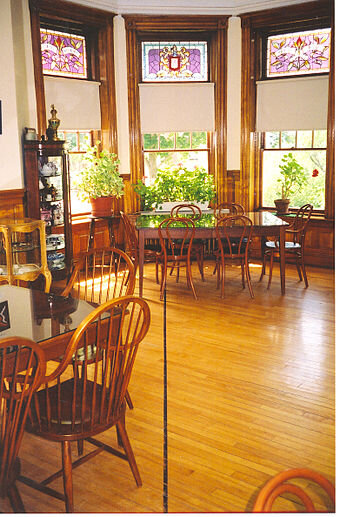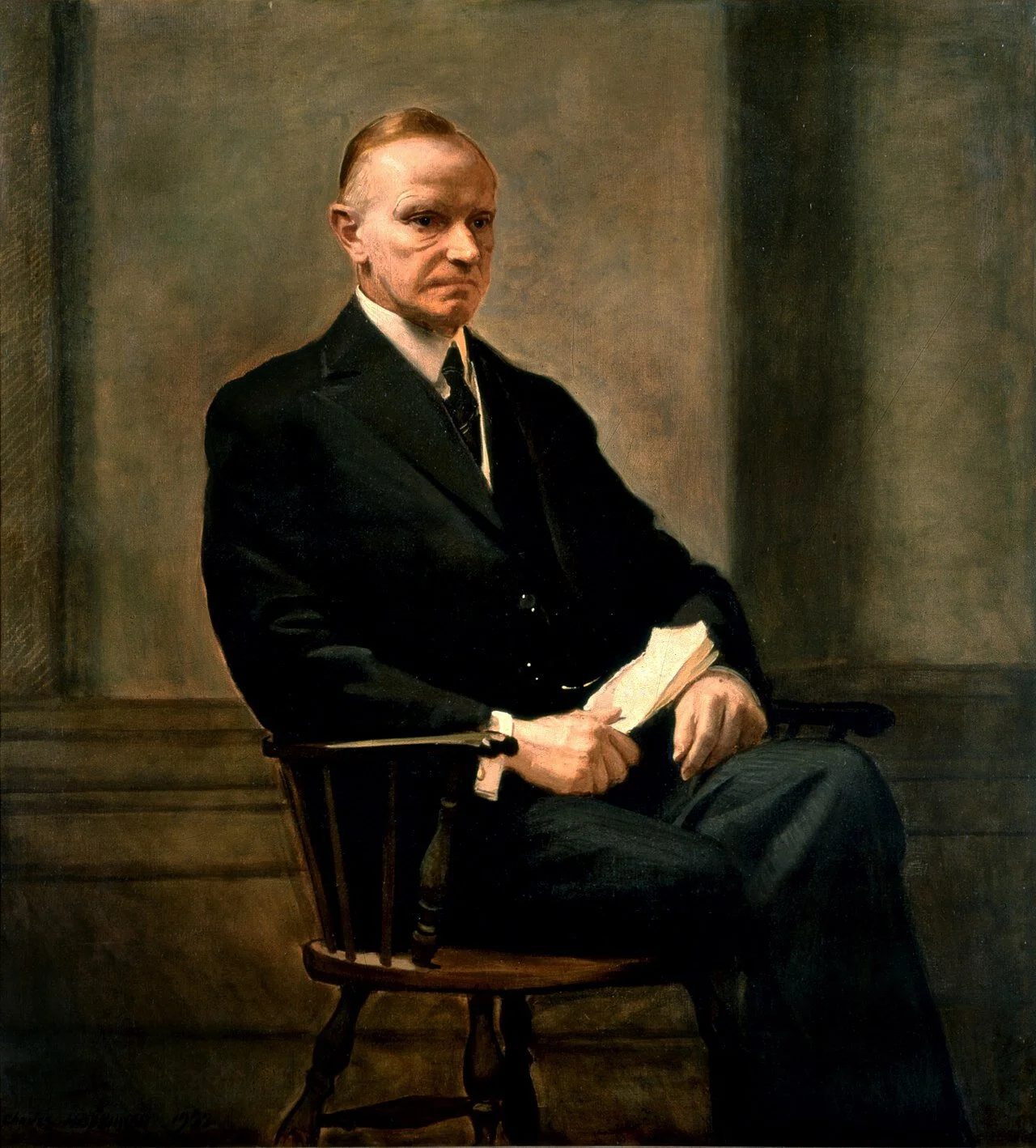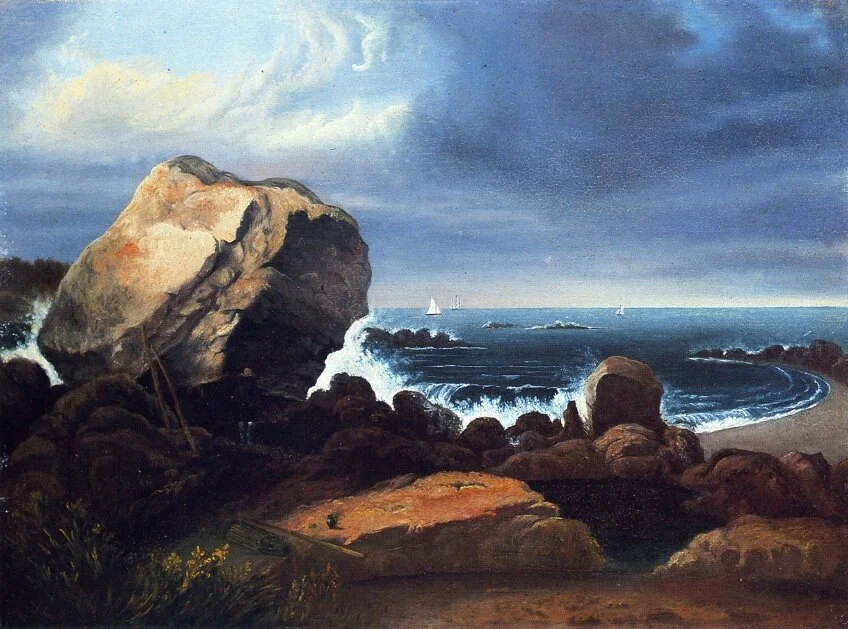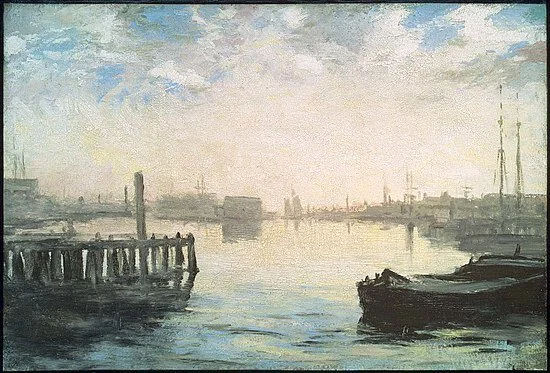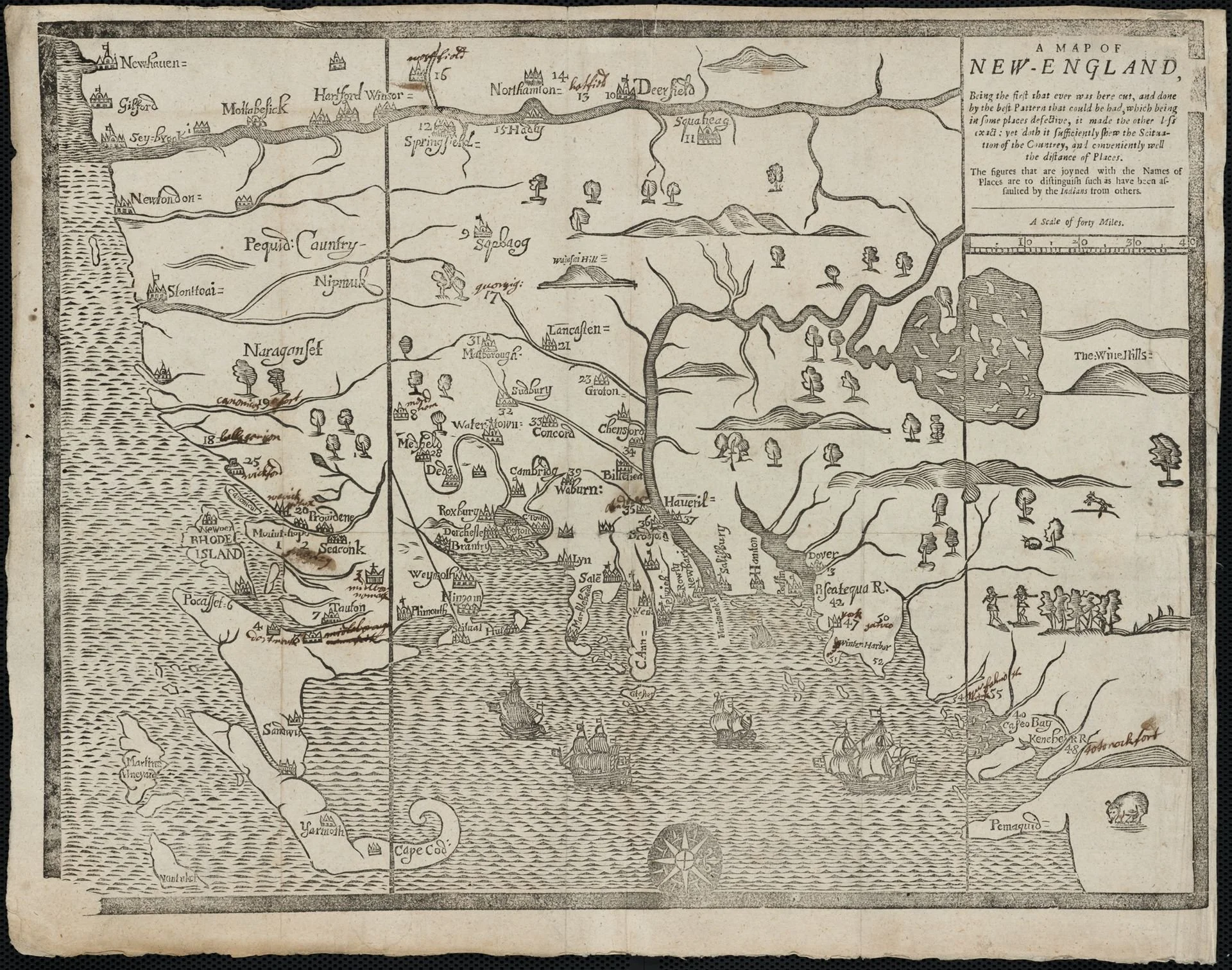
Spring IS coming
“Efflorescence” (oil on canvas), by Stacey Cushner, in her current show of the same name at Kingston Gallery, Boston
The gallery says: The work “was created as a means to provide daily certainty amidst global suffering. Turning to an almost scientific process to glazing with oil paint, Cushner used the pandemic lockdown to learn glazing techniques and keenly observe the natural world. Her study of plant life drew out the fundamental aspect of being wholly present at the moment, a realization found only once the pandemic changed everything. Using flowers, particularly tulips, to symbolize love and rebirth, Cushner seeks to remind viewers of spring’s endless possibilities.’’
He studio is in Boston’s South End. See: https://www.staceycushner.com/about
Aerial view of the South End
— Photo by Richard Schneider
South End street scene
Llewellyn King: Far too early to starve the fossil-fuel sector
The Mystic Generating Station, in Everett, Mass,. can burn both natural gas and petroleum, but mostly burns natural gas.
WEST WARWICK, R.I.
In politics, any idea can be pressed into service if it fits a purpose. The one I have in mind has been snatched from its Republican originators and is now at work on the left wing of the Democratic Party.
The idea is “starve the beast.” It came from one of President Ronald Reagan’s staffers and was used to curb federal spending.
It was a central idea in the Republican Party through the Reagan years and was taken up with vigor by tax-cutting zealots. It was on the lips of those who thought the way to small government was through tax cuts, i.e., financial starvation.
Now “starve the beast’ is back in a new guise: a way to cut dependence on oil and natural gas.
This is the thought behind President Biden’s decision to revoke the permit for the Keystone XL pipeline, bringing oil to the United States from Canada, even after the expenditure of billions of dollars and an infinity of studies.
It is the idea behind banning fracking and restricting leases on federal lands. Some Democrats and environmental activists believe that this blunt instrument will do the job.
But blunt instruments are unsuited to fine work.
It also is counterproductive to set out to force that which is happening in an orderly way. The Biden administration shows signs of wanting to do this, unnecessarily.
Lumping coal, oil and gas as the same thing under the title “fossil fuel” is the first error. In descending order, coal is the most important source of pollution, and its use is falling fast. Oil continues to be the primary transportation fuel for the world. World oil production and use hovers around 100 million barrels a day — and that has been fairly steady in recent years.
In the United States, the switch to electric vehicles is well underway and in, say, 20 years, they will be dominant. Likewise, in Europe, Japan, and China. That train has left the station and is picking up steam.
Government action, like building charging stations, won’t speed it up but rather will slow it down. The market is working. Willing buyers and sellers are on hand.
Every electric vehicle is a reduction in oil demand. But the world is still a huge market for petroleum and will be for a long time. What sense is there in hobbling U.S. oil exports? There are suppliers from Saudi Arabia to Nigeria keen to take up any slack.
Natural gas is different. It is a superior fuel in that it has about half the pollutants of coal and fewer than oil. It is great for heating homes, cooking, making fertilizers and other petrochemicals. Starving the production just increases the cost to consumers.
The real target is, of course, electric utilities. They rushed to gas to get off coal. It was cheaper, cleaner and more manageable. Also, gas could be burned in turbines that are easily installed and repaired. Boilers not needed; no steam required.
But there are greenhouse gases emitted and, worse, methane leaks at fracking sites and from faulty pipelines throughout the system. These represent a grave problem. Here the government can move in with tighter regulation. If it is fixable, fix it. But methane leaks are no reason to cripple domestic production.
The question for the beast-starvers comes from Clinton Vince, who chairs the U.S. energy practice and co-chairs the global energy practice of Dentons, the world’s largest law firm. He asks, “Is it better to sell natural gas to India and China or to let them build more coal-fired plants? Particularly if carbon-capture and sequestration technology can be improved.”
If we are to continue to reduce carbon emissions in the United States, we need to take a holistic view of energy production and consumption. Does it make sense to allow carbon-free nuclear plants to go out of service because of how we value electricity in the short term? A market adjustment, well within government purview, could save a lot of air pollution immediately.
The hydrocarbon beast doesn’t need to be starved, but a diet might be a good idea.
On Twitter: @llewellynking2
Llewellyn King is executive producer and host of White House Chronicle, on PBS. He’s based in Rhode Island and Washington, D.C.
New Hampshire's 'pinched little joykillers'
The New Hampshire quarter, minted in 2000. But the Old Man of the Mountain (which brooded over Franconia Notch) fell apart on May 3, 2003.
A composite image of the Old Man of the Mountain created from images taken before and after the collapse.
— Alexander Theroux (born in 1939 in Medford, Mass.), American poet and novelist. He’s a brother of the better known travel writer and novelist Paul Theroux.
The state seal. The ship is a reference to the state’s Port of Portsmouth, which long played a key role in the state’s economy.
But no check cashing
Note the 1967 prices at the late lamented Hilltop Steak House in Saugus, Mass.
Phil Galewitz: Vt., N.H. and Maine are pushing to import Canadian drugs
The Haskell Free Library and Opera House straddles the border in Derby Line, Vt., and Stanstead, Quebec. The dark line shows the exact border.
Vermont, New Hampshire and Maine, all bordering on Canada, as well as Florida and Colorado, are moving ahead with efforts to import prescription drugs from Canada, a politically popular strategy greenlighted last year by then-President Trump.
But it’s unclear whether the Biden administration will proceed with Trump’s plan for states and the federal government to help Americans obtain lower-priced medications from Canada.
During the presidential campaign, Joe Biden expressed support for the concept, strongly opposed by the American pharmaceutical industry. Drugmakers argue it would undercut efforts to keep their medicines safe.
The Pharmaceutical Research and Manufacturers of America, an industry trade group, filed suit in federal court in Washington, D.C., to stop the drug-purchasing initiatives in November. That followed the Trump administration’s final rule, issued in September, that cleared the way for states to seek federal approval for their importation programs.
Friday was the deadline for the government to respond to the suit, which could give the Biden administration a first opportunity to show where it stands on the issue. But the administration could also seek an extension from the court.
Meanwhile, Florida and Colorado are moving to outsource their drug importation plans to private companies.
Florida hired LifeScience Logistics, which stores prescription drugs in warehouses in Maryland, Texas and Indiana. The state is paying the Dallas company as much as $39 million over 2½ years, according to the contract. That does not include the price of the drugs Florida is buying.
LifeScience officials declined to comment.
Florida’s agreement with LifeScience came last fall, just weeks after the state received no bids on a $30 million contract for the job.
Florida’s importation plan calls initially for the purchase of drugs for state agencies, including the Medicaid program and the corrections and health departments. Officials say the plan could save the state in its first year between $80 million and $150 million. Florida’s Medicaid budget exceeds $28 billion, with the federal government picking up about 62% of the cost.
On Monday, the Colorado Department of Health Care Policy and Financing issued a request for companies to bid on its plan to import drugs from Canada. Unlike Florida’s plan, Colorado’s would help individuals buy the medicines at their local pharmacy. Colorado also would give health insurance plans the option to include imported drugs in their benefit designs.
Kim Bimestefer, executive director of Colorado’s Health Care Policy and Financing agency, said she is hopeful the Biden administration will allow importation plans to proceed. “We are optimistic,” she said.
Her agency’s analysis shows Colorado consumers can save an average of 61% off the price of many medications imported from Canada, she added.
Prices are cheaper north of the border because Canada limits how much drugmakers can charge for medicines. The United States lets the free market determine drug prices.
The Canadian government has said it would not allow the exportation of prescription drugs that would create or exacerbate a drug shortage. Bimestefer said that her agency has spoken to officials at the Canadian consulate in Denver and that officials there are mainly concerned about shortages of generic drugs rather than brand-name drugs, which is what her state is most interested in importing since they are among the most costly medicines in the U.S.
Colorado plans to choose a private company in Canada to export medications as well as a U.S. importer. It hopes to have a program in operation by mid-2022.
But skeptics say getting the programs off the ground is a long shot. They note that Congress in 2003 passed a law to allow certain drugs to be imported from Canada — but only if the secretary of the Department of Health and Human Services agreed it could be done safely. HHS secretaries under Presidents George W. Bush and Barack Obama refused to do that. But HHS Secretary Alex Azar gave the approval in September.
Biden’s HHS nominee, Xavier Becerra, voted for the 2003 Canadian drug-importation law when he was a member of Congress.
HHS referred questions on the issue to the White House, which did not return calls for comment.
Trish Riley, executive director of the National Academy for State Health Policy, said that states have worked hard to set up procedures to ensure drugs coming from Canada are as safe as those typically sold at local pharmacies. She noted that many drugs sold in the United States are already made overseas.
She said the Biden administration could choose not to defend the importation rule in the PhRMA court case or ask for an extension to reply to the lawsuit. “Right now, it’s murky,” she said of figuring out what the Biden team will do.
Ian Spatz, a senior adviser with consulting firm Manatt Health, questions how significant the savings could be under the plan, largely because of the hefty cost of setting up a program and running it over the objections of the pharmaceutical industry.
Another obstacle is that some of the highest-priced drugs, such as insulin and other injectables, are excluded from drug importation. Spatz also doubts whether ongoing safety issues can be resolved to satisfy the new administration.
“The Trump administration plan was merely to consider applications from states and that it was open for business,” he said. “Whether [HHS] will approve any applications in the current environment is highly uncertain.”
Phil Galewitz is a Kaiser Health News journalist.
Phil Galewitz: pgalewitz@kff.org, @philgalewitz
Coolidge's 'law of service'
Coolidge’s home in Northampton, Mass., from 1906-1930
Calvin Coolidge (1972-1933; president 1923-1929) states his philosophy;
‘T]here is a standard of righteousness that might does not make right, that the end does not justify the means, and that expediency as a working principle is bound to fail. The only hope of perfecting human relationships is in accordance with the law of service under which men are not so solicitous about what they shall get as they are about what they shall give. Yet people are entitled to the rewards of their industry. What they earn is theirs, no matter how small or how great. But the possession of property carries the obligation to use it in a larger service.…’’
The Coolidge family homestead, in Plymouth Notch, Vt.
'Body and self'
“Animeyed: Flamingo” (archival pigment print on Hahnemühle pap), one of the works of Flora Borsi at Lanoue Gallery, Boston.
The gallery says she ‘uses masterful photo manipulation to create surreal images that are thematically focused on identity, relationships, dreams, and universal emotions ranging from lust and desire to despair and loss.’’
“In her ongoing self-portrait series, Borsi often features the female body playing with hiding and revealing the eyes or face to leave only the feminine form, exploring questions of female representation and the relationship between body and self.’’
The Cape: Still beauty amongst the McMansions
Sesuit Creek, in East Dennis
From Robert Whitcomb’s “Digital Diary,’’ in GoLocal24.com
David Gessner’s 1997 book, A Wild, Rank Place, is a series of essays about, among other things, how Cape Cod has become exurbanized, such as with grotesque show-off McMansions replacing the low-to-ground, modest gray-shingled houses so identified with the Cape. And yet he can still savor its remaining windy and haunting beauty. It’s a subject that particularly appealed to me because part of my family were/are old Cape Codders; I’ve seen even more change than he has.
Mr. Gessner (born in 1961) lived off and on for years in a family summer house in East Dennis (sold a few years ago). It was the heart of his family.
The title is a phrase by Henry David Thoreau based on several trips he took to the Cape in the early 1850s that resulted in the book of essays called Cape Cod. But as Mr. Gessner’s book notes, Thoreau’s deforested Cape looked a lot different than it did in the 1600s, when the English arrived, and of course much different than the current version, where woods have grown back even as the number of houses and convenience stores explodes and car traffic worsens virtually every year.=
There is vivid and idiosyncratic nature and environmental writing here, mixed with an intense family memoir whose heart is Mr. Gessner’s effort to come to terms with the transitory nature of life, and especially mortality, and entropy, with his father’s fatal illness at the center of all that. There are also some charming pen-and-ink drawings by Mr. Gessner, who is a cancer survivor.
'Blowing in the same bare place'
One must have a mind of winter
To regard the frost and the boughs
Of the pine-trees crusted with snow;
And have been cold a long time
To behold the junipers shagged with ice,
The spruces rough in the distant glitter
Of the January sun; and not to think
Of any misery in the sound of the wind,
In the sound of a few leaves,
Which is the sound of the land
Full of the same wind
That is blowing in the same bare place
For the listener, who listens in the snow,
And, nothing himself, beholds
Nothing that is not there and the nothing that is.
— “The Snow Man,’’ by Wallace Stevens (1879-1955), Hartford-based lawyer, insurance executive and famed poet
Earliest known photo of a snowman, taken in Wales in 1853
On the other hand, Boston…
“There is no section in America half so good to live in as splendid old New England — and there is no city on this continent so lovely and loveable as Boston.’’
— Mark Twain, in 1871.
Boston Terrier
“This can be a cold place, Boston, and the weather is the least of it. We’re often unwelcoming to outsiders. We have a maddening habit of sniping at insiders. We have equal parts determination and aloofness proudly bred into our native bones like the hunting instincts in a championship dog.’’
— Brian McGrory, in the March 15, 2002 Boston Globe (of which he’s now the editor)
Don Pesci: Business and taxes in Conn.
Official portrait of Calvin Coolidge in the White House, by Charles Sydney Hopkinson
"The business of America is business."
-- Calvin Coolidge, president from 1923-1929
Connecticut Gov. Ned Lamont likes to talk shop with business people. A Hartford Courant story, “Gov. Ned Lamont tells Connecticut businesses he’s ruling out ‘broad-based’ tax increases,” will not please Democrat progressives in Connecticut who seem fully prepared to eat businessmen and businesswomen for lunch. The large and overbearing contingent of progressives in the state's Democratic Party caucus cannot be satisfied with sentiments such as this: “I’ve been pretty clear. I have no interest in broad-based tax increases,” Lamont told president of the Connecticut Business and Industry Association (CBIA) Chris DiPentima. And, he hastened to add, “Every governor, Republican or Democrat since, or including, Lowell Weicker, has done that and it did not solve the problem.”
The problem is, of course, lavish, continuing, long-term spending -- and consequent increases in taxes. Taxes in Connecticut have been permanent, while cost-cutting measures have been temporary; this is because the force driving spending is more powerful than the force that would, were it applied, reduce long-term costs permanently. If one discharges deficits by reducing such costs, tax increases would be unnecessary. And the prospect of unnecessary tax increases would reduce the influence of – just to pick one snout at the public trough – Connecticut’s imperious public employee unions. But reducing the influence of the state’s public employee unions would deprive Democrats of funds and worker bees they rely upon to win elections.
Lamont was not prepared to tell DiPentima that, during the rest of his first term as governor, he would deploy his considerable resources to remove SEBAC, a union political organization and lobbying group that some have characterized as Connecticut’s fourth branch of government, from collective bargaining with the state on salary and pension contracts. Some have argued that such contracts give union leaders a Keystone pipeline to the wallets of Connecticut taxpayers, in the process shifting from the General Assembly to Connecticut courts control over a taxing authority that belongs constitutionally to the legislative branch of government. Why aren’t state employee salary and benefit packages set unilaterally by the General Assembly, which alone is constitutionally authorized to take in and disperse tax money? (SEBAC, by the way, stands for State Employees Bargaining Agent Coalition.)
One may be certain that this is not a discussion Lamont will be having anytime soon with President Pro Tem of the Senate Martin Looney or Speaker of the House Matt Ritter, neither of whom are disposed to cut off their union related campaign funds to satisfy their less binding constitutional responsibilities.
Over a long period of time in Connecticut, dating possibly from the unlamented Lowell Weicker administration, Machiavellians within the Democratic Party have discovered that it does not matter a whit whether they employ a Big Stick on the backs of business men and women or whether such contributors are induced to open their pockets to Democrats through special preferments; both methods may be deployed at the same time without diminishing campaign contributions from Connecticut’s larger businesses. The Big Stick lashes are generally offset by Big Business preferments – tax carve-outs, low- or no-interest loans, taxpayer money bribes to induce large companies to remain with their necks on the tax butcher-block in Connecticut, an offer they can’t refuse that is usually overridden by some other low-tax, business hungry state.
Former Gov. Dan Malloy’s Office of Policy Management director, Ben Barnes, once asked by a courageous reporter why he wanted to raise taxes on hospitals, replied in the accents of infamous bank robber Willie Sutton when asked why he robbed banks, “Because that's where the money is.”
The state's revenue stream has been swollen by Connecticut-based financial firms, but these firms have wings on their heels and may move, at the drop of a tax hatchet, to other less predatory states. Lamont may have discovered this disposition on the part of financial firms during an occasion pillow conversation with his wife Annie, who is a successful venture capitalist and the moneymaker in the family.
For these reasons, Lamont may be genuinely indisposed to kill the goose laying Connecticut’s golden tax eggs. On the other hand, union leaders, who have twice refused attempted Lamont cutbacks in their court supported salary and benefits contracts, are barking for MORE spending, as always, and the Democrat-dominated General Assembly is barking for MORE taxes, as always.
For now, Lamont has drawn a red line on “broad-based tax increases.” Lamont has a veto power he has not yet promised to deploy on behalf of a beleaguered CBIA or businesses destroyed through governmental edicts. Democrat leaders in the House and Senate know they have majorities nearly large enough to overcome vetoes.
“The game,” as Sherlock Holmes might say, “is afoot.” Pity there is no Coolidge on Connecticut’s political horizon.
Don Pesci is a Vernon-based columnist.
Bone art
“Alterant Emanation Emergence,’’ by southern Connecticut-based Miller Opie, in her show through Jan. 31 at Fountain Street Fine Art, Boston
She says
“My work is directly related to 3+ years of surgeries {on her jawbone} I had several years ago. But it is also rooted in my love of nature and the organic objects I use. My practice is constant: I look for treasures wherever I am. I pick up feathers on the sidewalk in the city. I find shells on the beach. And I collect bones on hikes in the forest behind my studio. Friends also find and give me things to add to my trove.’’
Alone, I think
“The February road to the river is mud
and dirty snow, tire tracks and corncobs
uncovered by the mildness. I think I am
living alone….’’
— From “To Be Here,’’ by Linda Gregg (1942-2019), an American poet who was living in Northampton, Mass., on the Connecticut River, when he she wrote this.
First Church, Main Street, Northampton
— Photo by chipmunk_1
The indoor sport invented in response to New England winters
The first basketball court, at what became Springfield College
“The invention of basketball was not an accident. It was developed to meet a need. Those boys would not simply play ‘Drop the Handkerchief.’’’
James Naismith, the inventor of basketball, on his time at Springfield College
In December 1891, Naismith, a Canadian-American physical-education professor at the International Young Men's Christian Association Training School (today, Springfield College) in Springfield, Mass., sought to create a vigorous indoor game to help keep his students occupied and fit during the long New England winters. After rejecting other ideas as either too rough or poorly suited to gymnasiums, he wrote the basic rules and put up a peach basket.
The Basketball Hall of Fame, in Springfield
And mostly disposable
“Small Things”, by Marjorie Forte, in her show, with Antoinette Winters, “Language as Muse,’’ at Brickbottom Artists Association, Somerville, Mass., through Feb. 27
New England Council’s new virtual networking series
The New England Ensign, one of several flags historically associated with New England. This flag was used by colonial merchant ships sailing out of New England ports, 1686 – c. 1737.
From The New England Council (newenglandcouncil.com)
BOSTON
The New England Council is pleased to announce the launch of our new virtual networking series, Council Connections. We have heard from many members that one aspect of the Council that they have missed the most during the pandemic when in-person gatherings are not possible is the opportunity to network with fellow Council members across different industries and throughout the region. During this hour-long program, you will have the opportunity to meet and converse with other Council members in a series of smaller, randomly assigned group breakout sessions. Please note that due to technological constraints, capacity for this program is limited, however if there is interest, we hope to hold these sessions regularly.
How it will work:
The session will be conducted using Zoom. We strongly encourage you to connect on a desktop, laptop, or tablet with video enabled.
All participants will join the meeting and first be placed in a large general session, just like any other Zoom meeting.
Once all participants have joined the general session, Jim Brett will welcome everyone and give some brief opening remarks.
There will then be a series of four, 10-minute breakout sessions. During the breakout sessions, participants will be randomly placed into a smaller group meeting of five people total. During the 10-minute session, you will have the opportunity to converse with and get to know those in your breakout room.
Between each session, all participants will return briefly to the general session before being randomly placed in the next breakout session.
We will provide all participants with the full list of program participants including email addresses so that you are able to easily follow up with anyone you meet during the networking program.
Please note that the breakout session participants are randomly selected are we are not able to honor requests to connect with specific individuals. However, if there is someone you are interested in meeting, our staff is happy to help facilitate a connection separate from this event.
While these sessions will be open to all Council members across various industries, we are also considering some sector specific networking programs for our various policy committees.
We hope you will join us for the first Council Connections program, on Tuesday, February 9, 2021, from 1:00 – 2:00 p.m.
View of Cambridge, Mass., home of both Harvard and MIT and, as a result, a high concentration of startups in general and technology companies in particular
Brian Mullin/Sherelle Wu: Can colleges mandate that their employees get COVID-19 shots?
Via The New England Journal of Higher Education, a service of The New England Board of Higher Education (nebhe.org)
BOSTON
As COVID-19 cases continue to surge nationwide, the newly approved COVID-19 vaccines cannot come soon enough. Although higher- education institutions (HEIs) are not at the top of the priority list to receive scarce early doses of the vaccine, colleges and universities should prepare for how they will handle vaccination on their campuses.
In general, both public and private HEIs may mandate that their staff receive the COVID-19 vaccine once it becomes available to the general public and may discipline an employee who refuses to receive the vaccine without cause. The U.S. Supreme Court has upheld the constitutionality of a state vaccine mandate that was “necessary for the public health or the public safety” (Jacobson v. Massachusetts, 197 U.S. 11 (1905)) as well as the exclusion of students from both public and private schools due to refusal to receive a mandatory vaccine (Zucht v. King, 260 U.S. 174 (1922)).
Under the federal Occupational Safety and Health Act (OSHA), employers have an obligation to provide a safe workplace free from serious recognized hazards and should do their part to encourage compliance with governmental health and safety guidelines.
In practice, however, HEIs should be aware that staff may be entitled to medical exemptions under the Americans with Disabilities Act (ADA) and religious exemptions under Title VII. Institutions should have a uniform policy for staff to apply for such exemptions.
When an employee requests an exemption, both Title VII and the ADA require that the institution engage in an interactive process to determine effective accommodations or alternatives to vaccination specific to that employee. Such accommodations may include permitting the employee to work remotely; temporarily reassigning the employee to a different, less public-facing position or workstation; or allowing the employee to take a temporary leave of absence.
In certain circumstances, if the exemption poses an “undue hardship” to the employer, the HEI may deny the exemption and require that the employee receive the vaccination. An undue hardship under Title VII is defined as a minimal cost or burden to the employer’s operations. This will vary depending on the size and nature of the HEI, but can be any economic or noneconomic expense that would create a burden on its operation such as, for example, changes to schedules that increase payroll expenses or result in other employees working less desirable shifts. In comparison, an undue hardship under the ADA requires an HEI to show a “significant difficulty or expense,” a much higher standard to meet.
Under both statutes, consideration of an undue hardship includes both financial costs as well as cultural or operational costs such as whether the accommodation would compromise the integrity of a seniority system—for example, an HEI that has a collective-bargaining agreement which provides for seniority for bidding for positions. Relevant factors in considering an undue hardship in the vaccination context would include, the risk to the public due to noncompliance; the availability of an alternate means of infection control such as personal protective equipment (PPE); and the number of employees who actually request an accommodation.
While an employee’s refusal or inability to receive the vaccination may cause jealousy or friction between coworkers, such a conflict would not constitute an undue hardship unless the accommodation would infringe on the coworkers’ rights or ability to perform their duties in a safe way.
In deciding whether to mandate (rather than strongly encourage) staff COVID-19 vaccination, each college or university should carefully consider its own community needs and circumstances. For example, a medical or nursing school that employs certain staff in health-care facilities may have a much more compelling need to mandate vaccinations than an institution whose employees continue to operate on a mostly remote or hybrid basis. As the vaccination rollout varies widely from state to state, institutions should consult their own state’s laws and narrowly tailor their own vaccine policy to match their local public-health agency’s guidance.
HEIs considering mandatory vaccines should maintain an objective written policy based on business necessity (i.e. actual job requirements) and apply the policy consistently. The institution can narrowly tailor the mandate to apply only to specific departments or positions. For example, an institution could mandate vaccination only for public-facing staff positions which are required to perform work on-campus rather than positions that may be performed remotely. The HEI should educate their employees on the benefits of vaccination and the process to request an accommodation.
An institution that has decided to require compulsory COVID-19 vaccination should provide free and convenient vaccine administration to its employees and should ensure that staff can take the necessary time off from work to receive the vaccine and recover from any side effects if necessary.
Importantly, given the need to carefully track vaccine administration to ensure individuals receive both doses at the appropriate time, colleges and universities must be careful to safeguard the privacy of employees’ medical information, including keeping it separate from personnel files.
Since the currently available COVID-19 vaccines are approved on an emergency-use basis, HEIs should carefully watch any changes in approval, efficacy and best practices. For example, pregnant women were not included in the clinical trials and may be excluded from initial vaccine administration. Institutions should also look out for additional guidance from the Centers for Disease Control, Equal Employment Opportunity Commission, or OSHA.
Brian Mullin and Sherelle Wu are lawyers practicing in the Employment & Higher Education Groups in the Boston law firm of Bowditch & Dewey LLP.
Sam Pizzigati: Walgreens workers take the pandemic risks as chain's senior execs get even richer
A Walgreens store on Route 1 in Saugus, Mass.
Via OtherWords.org
BOSTON
Every week, millions of us walk into a Walgreens drugstore without giving it a second thought.
Maybe we should. Walgreens perfectly encapsulates the long-term economic trends of the Trump years: top corporate executives pocketing immense paychecks at the expense of their workers.
At Walgreens, workers start at just $10 an hour. No chain-store empire employing essential workers pays less.
And no retail giant in the United States has given its workers less of a pandemic hazard pay bump — just 18 cents an hour, according to Brookings analysts Molly Kinder and Laura Stateler.
These paltry numbers look even worse when we turn our attention to the power suits who run Walgreens, who face no pandemic hazard. Walgreens CEO Stefano Pessina took home $17 million last year. Altogether, the five top Walgreens execs averaged $11 million for the year, a 9 percent hike over the previous year’s annual average.
Meanwhile, the typical Walgreens employee pulled down a mere $33,396. Pessina’s take-home outpaced that meager reward by 524 times. In effect, Pessina made more in a single weekday morning than his company’s typical worker made for an entire year.
Kinder and Stateler found similar levels of greed at other U.S. retail giants, especially Amazon and Walmart. Amazon CEO Jeff Bezos and the heirs to the Walmart fortune, they note, “have grown $116 billion richer during the pandemic — 35 times the total hazard pay given to more than 2.5 million Amazon and Walmart workers.”
Amazon and Walmart, they add, “could have quadrupled the extra COVID-19 compensation they gave to their workers” and still earned more profit than the previous year.
Not every major corporate player has treated the pandemic as just another easy greed-grab. Workers at Costco — who start at $15 an hour, $5 an hour more than workers at Walgreens — got an extra $2 an hour in hazard pay.
Costco’s top executive team, interestingly, last year collected less than half the pay that went to their counterparts at Walgreens. Costco’s most typical workers took home $47,312 for the year. At 169 to one, that’s less than one-third the pay gap between Walgreen’s chief exec and his company’s most typical workers.
As a society, which corporations should we be rewarding — those whose executives enrich themselves at worker expense, or those that value the contributions all their employees are making?
In moments of past national crises, like World War II, lawmakers took action to prevent corporate profiteering. They put in place stiff excess profits taxes. We could act in that same spirit today. We could, for instance, raise the tax rate on companies that pay their top execs unconscionably more than their workers.
We could also start linking government contracts to corporate pay scales: no tax dollars to any corporations that pay their CEOs over a certain multiple of what their workers take home.
Efforts to link taxes and contracts to corporate pay ratios have already begun.
Voters in San Francisco this past November opted to levy a tax penalty on corporations with top executives making over 100 times typical San Francisco worker pay. Portland, Oregon took a similar step in 2018. At the national level, progressive lawmakers have introduced comparable legislation.
Donald Trump may be gone, but the executives who did so well throughout his tenure remain in place. We need to change the rules that flatter their fortunes.
Sam Pizzigati, based in Boston, is the co-editor of Inequality.org and author of The Case for a Maximum Wage and The Rich Don’t Always Win.
Distraction via exploration
“Scituate Beach, Massachusetts,’’ byThomas Doughty, 1837
From Robert Whitcomb’s “Digital Diary,’’ in GoLocal24.com
When things in the world in general and/or in your own little world in particular seem almost intolerably tense, you can’t beat wandering around in nature without an itinerary for relief. I remember that fondly from my boyhood in a small, still partly rural, town on Massachusetts Bay. Alone, or with a pal or two, I’d go “exploring’’. And it was a good place to explore.
There were beaches, more pebbles than sand, with rocky headlands and innumerable sea birds, some of which would attack if you approached their nests. There were shark’s eggs to pick up, along with lovely sea glass (this was before the explosion of plastic pollution), and horseshoe crab shells amidst the seaweed dumped on the beach at the high-tide mark. (There were also tin cans to shoot at with BB guns.)
After northeast storms, we’d look for small boats that might have been tossed ashore.
Nearby were bullrush forests along the marshes, through which we’d make trails leading to little “rooms” we’d create. We’d use rowboats to explore the tidal rivers through the marshes, with their often sulfurous smells.
Sometimes in midwinter the more brackish and less salty marsh streams would freeze up and we’d do our exploring on skates.
Inland, small streams beckoned us to find their sources, and we’d check out a nearby farm, fragrant in certain weather with the aroma of manure, where we would sometimes intentionally irritate the bulls. There were rock-topped mini-mountains and tall oak trees to climb and abandoned houses to trespass in. (See poem fragment above.) And everywhere pleasing smells, such as of cedar trees, of which we had a lot, and flowering trees in May, of wet, newly cut grass and of rotting apples on the ground in the fall.
And the sights, smells and sounds could vary much from day to day, with the sharpest changes in early spring. Every day’s light was different.
What a miraculous world!
— Photo by Stefan-Xp
While this winter has generally been milder than usual, it looks like we won’t be getting the “January Thaw” – that sweet stretch of days with temps in the 50s that we often get at this time of year in New England, giving us a tempting taste of spring. A January Thaw would have been particularly appreciated by COVID-desperate restaurant owners because they could more comfortably serve customers outdoors.
Meanwhile, while most (?) New Englanders like mild winters, that our winters are getting warmer and shorter is a bad sign for the world, showing that man-fueled global warming is speeding up.
'The port is near'
Gloucester Harbor ca. 1877, by William Morris Hunt
It is time to be old,
To take in sail:—
The god of bounds,
Who sets to seas a shore,
Came to me in his fatal rounds,
And said: “No more!
No farther shoot
Thy broad ambitious branches, and thy root.
Fancy departs: no more invent;
Contract thy firmament
To compass of a tent.
There’s not enough for this and that,
Make thy option which of two;
Economize the failing river,
Not the less revere the Giver,
Leave the many and hold the few.
Timely wise accept the terms,
Soften the fall with wary foot;
A little while
Still plan and smile,
And,—fault of novel germs,—
Mature the unfallen fruit.
Curse, if thou wilt, thy sires,
Bad husbands of their fires,
Who, when they gave thee breath,
Failed to bequeath
The needful sinew stark as once,
The Baresark marrow to thy bones,
But left a legacy of ebbing veins,
Inconstant heat and nerveless reins,—
Amid the Muses, left thee deaf and dumb,
Amid the gladiators, halt and numb.”
As the bird trims her to the gale,
I trim myself to the storm of time,
I man the rudder, reef the sail,
Obey the voice at eve obeyed at prime:
“Lowly faithful, banish fear,
Right onward drive unharmed;
The port, well worth the cruise, is near,
And every wave is charmed.”
“Terminus,’’ by Ralph Waldo Emerson (1803-1882) the American essayist, lecturer, philosopher, and poet who led the New England-based transcendentalist movement of the mid-19th Century.







